1-2 October 2011: Vieste, Italy
We left Pompeii and decided to drive to Vieste which is on the furthermost tip of eastern Italy. It is usually a beachside resort, but as it is winter, we thought it might be quite and give us a chance to laze by the beach and do nothing for a few days. We jump on the motorway and before you know it we are suddenly following a magnificent coastal road clinging to the cliffs with hardly any other traffic and viewing the Golfo di Manfredonia. We arrive in Vieste to find this town almost entirely shut up, it is like a ghost town. There are loads and loads of campsites, but all locked up. We have found a campsite in the ACSI book called Vill. Baia degli Aranci so head there. It certainly looks stunning from the pictures and is kind of a motorhome park behind the hotel; however you have access to all the facilities. So we park up and unload Vinnie and find a British couple nearby who advice that the washing machines are free – well it is like Christmas and before you know it we have all the machines going with everything we own. We also find out there is free wifi, so we are on that like seagulls on a hot chip. Eventually we have everything on our clothes lines and head off into town. It isn’t a large town with a population of approximately 14,000 – in summer and about 50 in winter. There is an old part of the town (centro storico) that is negotiated via small, steep and cobblestoned walks where you get fantastic views of the ocean and the cliffs. We wandered up and down sideways and every other way through the beautiful streets, noting some of the restaurants that may look promising for dinner. Eventually we walked back along the harbour and the beach to the campsite to find the washing all dry – perfect. We put on some clean clothes and headed back into town, which has all of a sudden come to life and found the restaurant Al Cantinone which is recommended in the Lonely Planet and we have been staying away from these, but this was something different, the food was fantastic, wine matched perfectly and the waitress spoke great English and was very helpful. So replete we headed back to Vinnie.
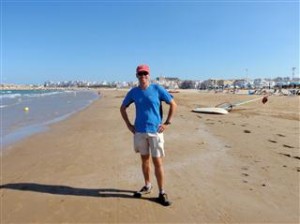
The next day we rewandered the area and Scott went for a run whilst we finished off some more washing. It was pretty windy today so Tracy lazed around reading and not doing much.
3 October 2011: Ascoli Piceno, Italy
We are driving along the coast today before veering into the middle of Italy and through some of the mountainous region towards Scanno. We found a parking spot for Vinnie amongst the local buses (just east of the town) and walked up to through the steep alleyways into the town. Scanno is beautiful, but alas, we arrived during siesta and everything was shut, so it was like wandering through a ghost town. According to the Lonely Planet it is an exhilarating drive up (what a total understatement) and it is definitely worth the views of Lago di Scanno and the town is fantastic with lots of old nonna’s grapping any spot to sit in the afternoon sun. The main square is the Piazza del Popola which has been standing since roman times (by now Scott just glazes over with the mention of Roman or Etruscan ruins and doesn’t even do Monty Python jokes anymore). If you don’t enjoy the architecture of the town you can just view the gorgeous surrounding mountain views which are along just jaw dropping. We stopped at a local cafe for a coffee and a cake and enquired about the supermarket and were told it opened at 4pm, however at 4:30pm we gave up and wandered back to Vinnie and drove on.
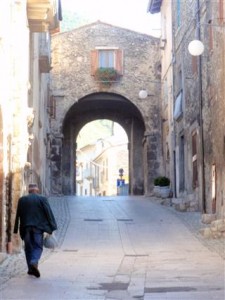
4-5 October 2011: Assisi, Italy
Norcia: We had been warned that this was the town with lots of wild boar heads in the windows and we weren’t led astray, they are everywhere as Norcia is purported to make the best salami and the area is surrounded by producers of black truffle. However the area is beautiful and Norcia is lined with shops and local producers as well as being home to a gorgeous church.
We are staying at Camping Village Assisi (EUR15), however although it says in the book you get a shuttle to the town, you have to pay for it, so we decided to walk. You see Assisi as you are approaching from the distance and it certainly looks like a spiritual capital. So what is it famous for – St Francis of Assisi was born here in 1181 and preached here until he died in 1226. This is not just a shrine to him but also a working monastic town and we were lucky enough to arrive on the last day of a festival which saw the pilgrim hoards descend. After climbing the incredibly steep shortcut (24% gradient) we arrived just outside the main cathedral (Basilica di San Francesco) where we joined the religious masses to visit St Francis’ tomb. I have to say I am not that religious but this was quite a moving experience.
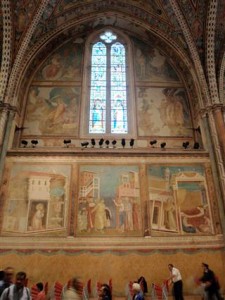
There are several levels to the Basilica, the lower level (built between 1228 and 1230) where you can go down to the crypt of St Francis and then the upper level (built between 1230 and 1253) which you can access through the monastic cloisters. I am not sure why St Francis is so popular still today, maybe it is because even back in the 11-12th century he preached the virtues of poverty and equal respect he was also the first Dr Dolittle and this affinity may be what attracts people today. The frescos in the church are interesting and you can easily spend a lot of time just working through them (purportedly painted by Giotto) and they make a welcome and refreshing change from the Byzantine and Romanesque art in other Basilica’s. You can also visit the Sala delle Reliquie and view items of St Francis’ life, although it should be noted that you can also see a piece of his tunic in Florence. From there all roads lead up through a lovely little town littered with shops, cafes, restaurants, local producers, boutique hotels and homes. And if you are feeling a bit lost without a day of roman or Etruscan ruins, don’t fear there were more here – much to Scott’s excitement (not). We spent the afternoon wandering through the streets stopping for a wine. Unfortunately it started to get dark and we realised we had a three kilometre trek back to the campsite in the dark. It was an achievement to make it in one piece and there was no edge to the road.
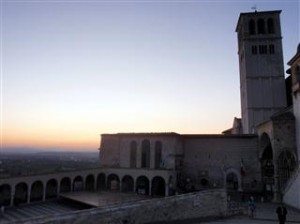
Up early the next day and back into town to do some more sightseeing now that the crowds have left and the television cameras etc are packed away.
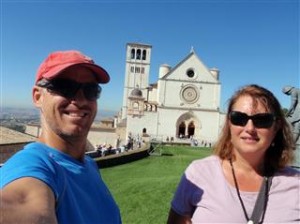
We stopped for a coffee towards the upper level of the town and if you are a St Francis buff you can easily visit a plethora of sites attributed to him. We eventually headed back to a local vineyard to find it shut, but this time made it back to the campsite just as it was getting dark.
6 October 2011: Torgiano, Italy
Perugia: We are heading to Perugia which according to the Lonely Planet is one of Italy’s best-preserved hill towns. Hmm parking was a nightmare and we parked in a motorhome spot but were dubious about it. We walked up and up and up finally getting to within the city walls to find a dreary town that did not stand out from many of the other towns we had drive through although it was bigger, much bigger and we did a quick walk around the main area including the Corso Vannucci (supposedly the centre of Umbria and also the meeting point for ancient Etruscan and Roman civilisations), Rocca Paolina, Piazza Italia and Piazza IV Novembre (which has a fountain and cathedral).
Torgiano: I read about an Aire in Torgiano so we headed there and a walk through the town. This town is famous for its wine and olive oil and is only a short drive from Perugia. The village is relatively flat for a change, so we wandered through the streets. Unfortunately it was mid afternoon so both the Olive Oil and Wine Museums were shut, so we headed to Ristorante Siro for lunch. This is where the town seemed to have congregated and we had an awesome meal, although the deserts were disappointing. As we have a parking spot, so also enjoyed some wine. Eventually we headed back through the town to the Museo del Vino which traces the history of the production of wine in the region, unfortunately it wasn’t so much about wine making as it was about the history, so although interesting, the most interesting part was the pictures etc of how things have changed. Just up the road was the Museo dell’Olivo e dell’Olio which is also a well organised museum, but again didn’t focus as much on the local area as we hoped. Back at Vinnie we find the local Aire is also next door to the local football strip, but never fear the Italians showed up late and then only did a quick jog around the field before disappearing.
7 October 2011: Todi, Italy
Deruta: I really like majolica ceramics so we are heading to the place it is manufactured. We find a parking spot and walk up the main street which has a gazillion shops all selling mostly the same stuff with the odd exception of some very huge ugly pieces. Empty handed I give up and we head off.
Spoleto: A bit of a drive away, but in the pictures this looks like the perfect Umbrian town. It is now famous for the Festival dei Due Mondi which we are missing but it is a roman town full of ruins and apparently very wanderable. Okay my idea of very wanderable is minimal uphill, this is not the case here. You park at the bottom of the town and then walk up, up and more up. Although the streets are pretty and there is a huge amount of history here. Umbria was first divided between the Etruscans and the Umbrians, but when Rome fell it was divided again between the Byzantines and the Lombards, Spoleto became the capital of the Lombardy region in AD890 (yes it is a long time ago), but you can see many buildings that hint at this period. We head for the Piazza della Liberta which is the centre of town and also houses the tourist office. From this square you can easily view the roman parts of Spoleto via the Museo Archeologico, although we didn’t go in, you can see a considerable amount of well displayed ruins from the streets above. Back at the Piazza Duomo we visited the cathedral which although consecretated in 1198 was mostly remodelled in the 17th century.
Todi: After a day of roman ruins, Scott was glazing over so we headed to Todi and an Aire which is at the bottom of the town but easy to navigate. There is a furniculare that takes you up to the town which takes out all the fun of walking up (what a shame). So for once we take the lazy option and catch the furniculare. Todi is then a short walk to the town centre which is really nice and a surprise. You get a great view of the surrounding countryside. The cobblestone streets slow you down so you get plenty of opportunity to wander through the shops and take in the fantastic roman and Etruscan walls which are very much a part of the current housing and streets. We found the Piazza del Popola and sat on the medieval stairs just watching people wander by. The weather is quite cold today, but there is plenty of bustle around the square. We eventually make our way to the Chiesa di Santa Maria della Consolazione which is totally different to most churches in look and feel with a huge cupola-topped dome that you can spy from a great distance.
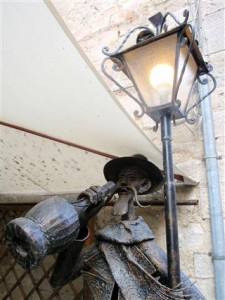
8 October 2011: Orvieto, Italy
We drive into Orvieto and find an Aire, bit pricey, but next to a furniculare (liking these methods of getting up to the towns), plus it has showers, toilets, a washing machine and you can even order fresh bread to be delivered the next day. We catch the Furniculare up to Orvieto which is perched on the side of a cliff and then decide to catch the local bus to the town centre. The bus is small but only just fits through the tiny streets and you are dropped off in front of the Gothic cathedral in Piazza Cahen. Now I hadn’t read the guidebook on Orvieto so when Scott mentioned it was supposedly a visual feast, nothing can prepare you for your first glimpse of the Cathedral, it is awesome and breathtaking. Originally started in 1290 and finally finished three centuries later, this is the most detailed facade of nearly every building we have seen ever. There is so much to look at and see, no the wonder there are crowds on the steps. The inside is also interesting with a great fresco of The Last Judgement by luca Signorelli which was meant to have been the inspiration for Michelangelo and after seeing both, I think Signorelli’s work outshines Michelangelo. Of course Orvieto isn’t just the Cathedral and we visited the Museo dell’Opera del Duomo, Torre del Moro, Chiese di Sant’Andrea, Palazzo del Popolo and finally the Chiesa di San Giovenale before Scott gave up on churches for the day.
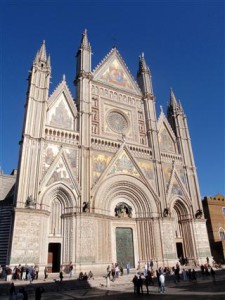
9 October 2011: Passignatio, Italy
Lago Trasimeno: We are having a break from Roman, Etruscan and Churches for the day and heading to Lago Trasimeno which is full of walking trails and water sports. However, the weather is cold and we give up on the two Aires we look at as they are bleak and you have to pay, so decamp to a campsite(Kursaal at Passignano sul Trasimeno) where we got a spot near the lake. The town was very quiet, almost deserted, but we are now travelling outside of manic August and things shut down very quickly. The weather is turning icey and starts to rain so we give up on our walk and head back to Vinnie for something warm.